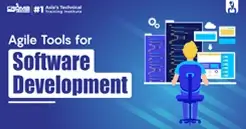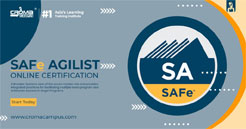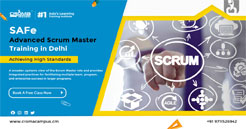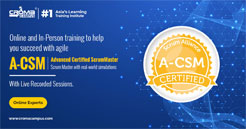What Is Agile Software Development? (Agile Methodologies)
4.8 out of 5 based on 4219 votesLast updated on 27th Feb 2023 6.8K Views
- Bookmark

The Agile software development system is an iterative procedure and has 6 steps to deliver work in small quantities. Read this blog.

Introduction
Agile is a repetitive software development and project management approach that helps organizations deliver value to their clients effectively. A software development team first explored the Agile methodology to speed up project processes. Instead of bringing drastic changes to the system, the Agile methodology delivers work in smaller quantities, ensuring a steady growth process. Modern organizations are increasingly choosing Agile software development processes to accelerate their system workflows and reduce the time between new product launches. The peak purpose of Agile software development is to break down the product development process to minimize up-fronting and design planning. Therefore, Agile is an effective way to simplify an employee's work during software development. Students and professionals can choose Agile Online Course to enhance their proficiency in Agile methodologies.
Benefits Of Agile
Simply put, Agile software development helps enterprises speed up their production process. The key benefits of the Agile methodology are as follows
- Enhanced quality of work
- Customer satisfaction
- Increased business value
- Better alignment and visibility
- Better communication
- Adaptability
- Reduced risks
The 4 Pillars of Agile
The Agile concept of software development functions on four main principles. The Manifesto for Agile Software Development, founded in 2001, provides an insight into the core values of the Agile project management approach. Below mentioned are the four pillars of Agile.
- Individuals And Interactions Over Processes and Tools
- Working Software Over Comprehensive Documentation
- Customer Collaboration Over Contract Negotiation
- Responding To Change Over Following A Plan
Agile Software Development Cycle
The Agile software development system is an iterative procedure that delivers work in small quantities. The Agile software development process involves six steps which are as follows.
- Concept: This is the first step of Agile software development. This step involves identifying business opportunities in the projects and estimating the work and time needed to complete the project.
- Inception: This second step involves choosing team members and raising funds for the project. Additionally, an extensive client discussion should be done to understand their requirements and provide teams with an outline of the responsibilities.
- Iteration/Construction: In this step, the teams start working on the program based on the client's requirements and feedback. The agile methodology is an iterative procedure. Therefore, the software development is broken down into several iterations. The completion of one iteration leads to the other. Multiple iterations are occurring at the same time, thus, creating a unique workflow.
- Release: This fourth step involves testing and resolving the remaining issues in the software developed. Additionally, the system and documentation are also finalized in this step.
- Production: This step focuses on the support needed to maintain the developed software. The developers ensure smooth software functioning and teach the users how to use the software. This step continues till the software product is planned for retirement.
- Retirement: This is the final stage of Agile software development and involves all the end-of-life activities, including removal of release from the production.
Types Of Agile Methodologies
The Agile approach is iterative, incremental, and evolutionary. There are various types of Agile methodologies to facilitate the Agile software development processes. Let us explore the different types of Agile methodologies.
1. Scrum
It is a lightweight Agile framework used by project managers to control various iterative and incremental projects. The project managers create and maintain a product backlog to list all the project requirements. This includes bug fixes, features and non-functional requirements. The backlogs are re-evaluated after every project completion to set new goals for other upcoming projects.
2. Lean Software Development
This iterative method uses effective value stream mapping to deliver value to customers. This methodology is flexible and evolving and does not require rigid guidelines. The Lean method focuses on increasing learning, empowering team members, fostering integrity, making late decisions, delivering fast products, etc.
3. Extreme Programming (XP)
XP is a disciplined approach and focuses on fast, continuous delivery. The XP methodology supports customer involvement, teamwork, rapid feedback, and continuous planning and testing. The XP method aims to improve software quality to meet customer requirements.
4. Crystal
This is the most adaptable and lightweight Agile methodology focusing on people and interactions. It comprises numerous Agile process models like Crystal Clear, Crystal Orange, and Crystal Yellow. The Crystal methodology emphasises frequent delivery, customer involvement, elimination of bureaucracy, adaptability, etc. Furthermore, its major principles include teamwork, simplicity, and communication.
5. Kanban
The Kanban methodology of Agile software development is highly visual workflow management. This methodology works on three basic principles:
- Visualizing the workflow
- Limiting the amount of work in progress
- Improving the flow of work
- It encourages team collaboration to enable Agile teams to work more efficiently.
6. Dynamic Systems Development Method (DSDM)
The DSDM methodology follows eight key principles – collaboration, on-time delivery, clear communication, demonstrated control, focus on business needs, iterative development, creation in increments, and refusal to compromise quality.
7. Feature-driven Development (FDD)
The FDD method begins by defining an overall model and creating a feature list. Next, the method focuses on feature-driven planning, designing, and software building. The FDD methodology is scalable and allows to breakdown of features if a large feature takes more time to build.
Conclusion
To sum up, the Agile methodology is an iterative project planning and development approach. Agile software development simplifies the workflow, thereby ensuring efficient project management. This incremental and evolutionary approach breaks down the entire project development process. The Agile software development process involves six steps: concept, inception, iteration, release, production and retirement. Furthermore, the four pillars of the Agile Manifesto emphasize employee interaction, effective documentation, customer collaboration, and change adaptability. Various institutes provide Agile Training in Gurgaon to enable professionals to plan and manage projects efficiently. Agile is a revolutionary approach gradually gaining popularity in the IT sector. There are different types of Agile methodologies like Scrum, Kanban, Crystal, FDD, DSDM, etc. The main benefits of Agile software development are enhanced customer satisfaction, better work quality, reduced risks, etc.
Subscribe For Free Demo
Free Demo for Corporate & Online Trainings.
Your email address will not be published. Required fields are marked *





















 Master in Cloud Computing Training
Master in Cloud Computing Training